By: Jillian M. Sico
As an artist, anthropologist, and book lover, I have long been fascinated by Mexico’s paper and bookmaking traditions. So when I began UA’s Book Arts MFA program last year, I jumped at the chance to learn more through a summer research trip to Mexico, supported by the School of Library and Information Studies and the Capstone International Center.
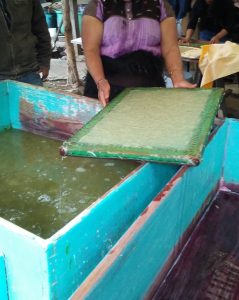 From as early as 800 AD, the Maya, Mexica, and Mixtec peoples created beautiful screenfold books containing hand-painted text and images, almost all of which were destroyed by the Spanish. But today, some artists in Mexico are working to revitalize and modernize their country’s paper and book traditions. Among them are the workshops Taller Leñateros in the city of San Cristobal
From as early as 800 AD, the Maya, Mexica, and Mixtec peoples created beautiful screenfold books containing hand-painted text and images, almost all of which were destroyed by the Spanish. But today, some artists in Mexico are working to revitalize and modernize their country’s paper and book traditions. Among them are the workshops Taller Leñateros in the city of San Cristobal  de las Casas and Taller Santos Rojas in the town of San Pablito.
de las Casas and Taller Santos Rojas in the town of San Pablito.
I visited Taller Leñateros in the state of Chiapas in late May 2018. The taller was started in 1975 by the poet Ambar Past with the goal of reviving the Maya art of bookmaking. Today, it employs local artists to make eco-friendly recycled paper and print and bind original artists’ books containing Maya songs, poetry, and stories in multiple languages. I did an intercambio, or knowledge exchange, with the four artists at Taller Leñateros. After I gave them bookbinding lessons, they taught me how to make paper from maguey fiber — the same plant used to produce tequila and mezcal. Before I left, I filled my suitcase with many beautiful (and heavy!) books, paper, and prints.
In early June 2018, I embarked on the second leg of my trip to learn about amate, a prehispanic type of bark paper. Artisans in San Pablito, Puebla have been continuously making amate since before the arrival of Cortes in 1519, first for books commissioned by the Aztecs and later for religious rituals. Contemporary amate makers are experimenting with different types of bark and are creating modern designs for everything from wall hangings to lampshades.
I took a workshop with Juan and Jorge of the Santos Rojas family, who taught me the entire process of making amate. First, we tromped in the woods to harvest mulberry and jonote bark, then headed back to the taller to cook the fibers over a small fire. The next day, I learned how to use a volcanic rock to pound the delicate fibers into thin sheets. The pounding process resulted in a lovely marbled-textured paper that I am excited to incorporate into my book work this semester.
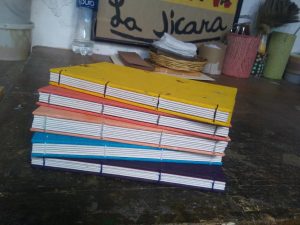 When I came back to Alabama in late June, I was struck by how we lead our lives almost entirely indoors — from house, to car, to work, to studio, and back again. In Mexico, I spent almost all of my days outdoors. People were always walking and working outside, exposed to the elements; and despite having limited resources and studio space, the artists I met were able to create high-quality, interesting books and paper. I was sad to leave, but I am also energized to spend more time outdoors here in Alabama and start new book projects inspired by my trip. I am incredibly grateful to the Capstone International Center and the SLIS Department for this opportunity.
When I came back to Alabama in late June, I was struck by how we lead our lives almost entirely indoors — from house, to car, to work, to studio, and back again. In Mexico, I spent almost all of my days outdoors. People were always walking and working outside, exposed to the elements; and despite having limited resources and studio space, the artists I met were able to create high-quality, interesting books and paper. I was sad to leave, but I am also energized to spend more time outdoors here in Alabama and start new book projects inspired by my trip. I am incredibly grateful to the Capstone International Center and the SLIS Department for this opportunity.
The Office of Academic Affairs and the Capstone International Center (CIC) are pleased to be able to offer limited funding to students and faculty who are participating in conferences and other opportunities abroad. Please visit the International Funding Request page to learn more.

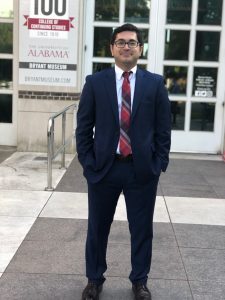
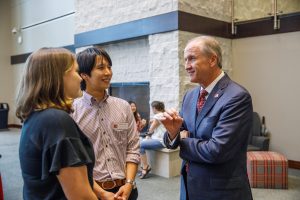
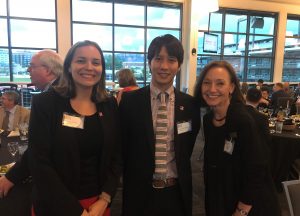
 From as early as 800 AD, the Maya, Mexica, and Mixtec peoples created beautiful screenfold books containing hand-painted text and images, almost all of which were destroyed by the Spanish. But today, some artists in Mexico are working to revitalize and modernize their country’s paper and book traditions. Among them are the workshops Taller Leñateros in the city of San Cristobal
From as early as 800 AD, the Maya, Mexica, and Mixtec peoples created beautiful screenfold books containing hand-painted text and images, almost all of which were destroyed by the Spanish. But today, some artists in Mexico are working to revitalize and modernize their country’s paper and book traditions. Among them are the workshops Taller Leñateros in the city of San Cristobal  de las Casas and Taller Santos Rojas in the town of San Pablito.
de las Casas and Taller Santos Rojas in the town of San Pablito. When I came back to Alabama in late June, I was struck by how we lead our lives almost entirely indoors — from house, to car, to work, to studio, and back again. In Mexico, I spent almost all of my days outdoors. People were always walking and working outside, exposed to the elements; and despite having limited resources and studio space, the artists I met were able to create high-quality, interesting books and paper. I was sad to leave, but I am also energized to spend more time outdoors here in Alabama and start new book projects inspired by my trip. I am incredibly grateful to the Capstone International Center and the SLIS Department for this opportunity.
When I came back to Alabama in late June, I was struck by how we lead our lives almost entirely indoors — from house, to car, to work, to studio, and back again. In Mexico, I spent almost all of my days outdoors. People were always walking and working outside, exposed to the elements; and despite having limited resources and studio space, the artists I met were able to create high-quality, interesting books and paper. I was sad to leave, but I am also energized to spend more time outdoors here in Alabama and start new book projects inspired by my trip. I am incredibly grateful to the Capstone International Center and the SLIS Department for this opportunity.

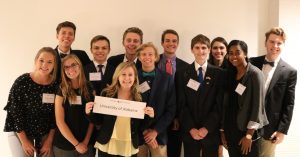
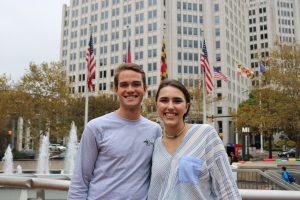 Mason Johnston and Abigail Kappelman won a Verbal Commendation award for their work representing Yemen in the United Nations Security Council (UNSC) committee as a double delegation.
Mason Johnston and Abigail Kappelman won a Verbal Commendation award for their work representing Yemen in the United Nations Security Council (UNSC) committee as a double delegation. Parnab Das’ love of researching the environment brought him to The University of Alabama. After responding to a UA Professor’s advertisement for a graduate assistant, he found himself 8,000 miles away from his hometown of Kolkata, India, working on a graduate degree in the Department of Civil and Environmental Engineering. Now, in his third year at UA he co-authored a grant from the EPA and is working on further environmental research. Parnab enjoys the academic challenges of UA, but is also involved with a number of on campus clubs and activities. He is the President of the International Student Association, as well as the Indian Students Association of Tuscaloosa. He is a Graduate School Senator and enjoys membership in the Human Relations Council and the Better Together Interfaith Team. This past April Parnab was recognized as the Best Student Officer of the Year at the Profiles in Service and Leadership Awards for his dedication to campus involvement and leadership. He helps to spread his home culture by organizing cultural events that celebrate Indian holidays and expose the campus community to new and interesting celebrations. This last year he organized both Diwali and Holi celebrations, in his capacity as the President of the Indian Students Association, which each drew over 500 people to celebrate the Indian culture and educate the UA community.
Parnab Das’ love of researching the environment brought him to The University of Alabama. After responding to a UA Professor’s advertisement for a graduate assistant, he found himself 8,000 miles away from his hometown of Kolkata, India, working on a graduate degree in the Department of Civil and Environmental Engineering. Now, in his third year at UA he co-authored a grant from the EPA and is working on further environmental research. Parnab enjoys the academic challenges of UA, but is also involved with a number of on campus clubs and activities. He is the President of the International Student Association, as well as the Indian Students Association of Tuscaloosa. He is a Graduate School Senator and enjoys membership in the Human Relations Council and the Better Together Interfaith Team. This past April Parnab was recognized as the Best Student Officer of the Year at the Profiles in Service and Leadership Awards for his dedication to campus involvement and leadership. He helps to spread his home culture by organizing cultural events that celebrate Indian holidays and expose the campus community to new and interesting celebrations. This last year he organized both Diwali and Holi celebrations, in his capacity as the President of the Indian Students Association, which each drew over 500 people to celebrate the Indian culture and educate the UA community.